Canadians and Americans currently drive the world's most climate polluting cars and trucks. On average they emit more than 60 tonnes of climate pollution (tCO2) each over their lifespan.
To meet our Paris Climate Agreement goals, all our cars and trucks will need to quickly transition to nearly zero-emissions.
The good news is that such climate-safe vehicles exist today — pure battery electric vehicles (BEVs) charged with fairly clean electricity. Many Canadians and Americans are already driving them.
The bad news is that the required transition away from climate-damaging vehicles is happening much too slowly. The legacy car makers are continuing to produce huge numbers of internal combustion engine (ICE) vehicles.
These gasoline burners are locking-in climate failure. But when it comes to BEVs, they are struggling to increase their sales despite ever greater number of models being introduced.
Instead, nearly all the growth in BEVs in Canada and the United States is coming from just one start-up company in California: Tesla. That's great for Tesla, but to meet our climate goals, the entire industry has to shift their sales to zero-emissions vehicles.
To bring you an illustrated guide to the climate threat from our cars and trucks, and what we can do about it, I've dug into dozens of reports and data sources and created a series of charts that tell the tale.
Buckle up, we're in for a bumpy ride...one way or the other.
The world's dirtiest cars and trucks
To start with, let's look at where we are today. A recent study by the International Energy Agency (IEA) shows that Canadians and Americans buy, and drive, the most climate polluting vehicles.
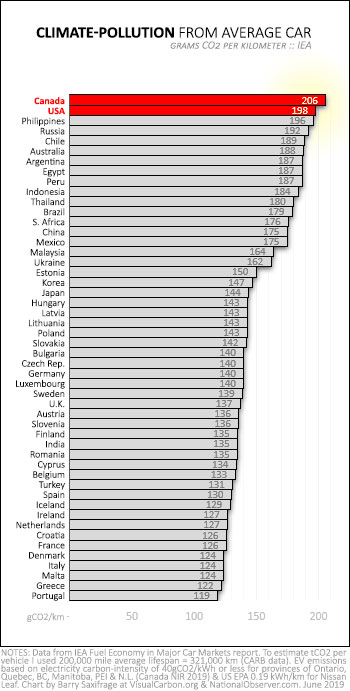
My first chart shows their data for the average passenger vehicle in different nations.
As you can see, Canadians top the chart with cars that emit an average 206 grams of CO2 (gCO2) per kilometre. That's just from the fuel used to move them around.
It's roughly equal to 8.7 litres of gasoline per 100 kilometres. American cars are only slightly less climate polluting.
If you want to visualize those 206 grams of climate pollution, picture tossing 400 plastic straws out the window, every kilometre.
As with our plastic pollution, nature will take thousands of years to remove our fossil fuel CO2 pollution from our air and oceans. (Note: if you are interested in the details of these and the other calculations in this article, see the geeky end notes.)
That's just the pollution from one kilometre. Next let's take a look at the total pollution emitted over a vehicle's lifespan.
Tonnes of gasoline, tonnes of pollution
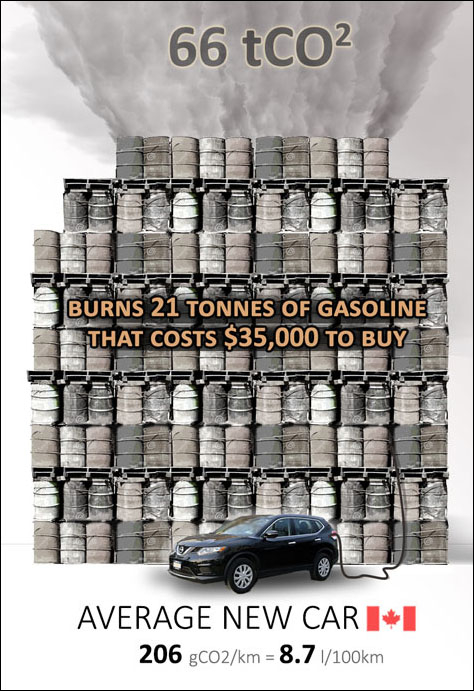
The average Canadian car will burn 21 tonnes of gasoline over its lifespan. As my graphic on the right illustrates, that's equal to around 130 barrels of gasoline.
Burning that much gasoline will release 66 tonnes of carbon pollution (66 tCO2) into our air. That's how much future pollution gets "locked in" on average each time a Canadian buys a new gasoline-burning vehicle.
At today's Canadian gas prices, the owner of the average car will pay around $35,000 to fill the tank over its lifespan.
In the US, it would cost a bit less. In Europe, it would cost twice as much, nearly $70,000, just to buy the gasoline. This helps explain why Europeans drive cars that pollute so much less per kilometre.
Too dirty for 2C
A few years ago, all the nations of the world signed the Paris Climate Agreement, agreeing to limit global temperature rise to a maximum of two degrees Centigrade above pre-industrial levels (+2C).
To illustrate how America's cars, SUVs and trucks fit into that goal, researchers at MIT did the math and created an interactive chart on their CarbonCounter.com website. The chart below is a version that I customized to use typical Canadian energy prices and electricity emissions. I've also added some labels.
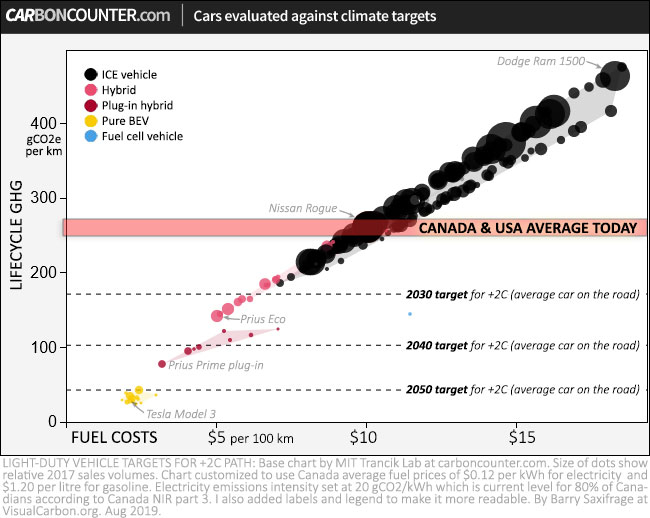
Each dot on this chart shows one specific model of car. I've labelled some examples.
The colour of the dots tells you what kind of fuel it uses. Black dots burn gasoline. Yellow dots use electricity. The reds use a mix.
And the size of the dots shows the relative number sold in the United States. Yeah...the dirtiest options are the most popular.
You can see just how much climate pollution each model emits by looking at where it is on the vertical axis. Importantly, this calculation includes the lifecycle emissions from producing the vehicle and the fuel to run it.
We saw above that the average Canadian car emits 206 gCO2/km just from burning the gasoline. When the full lifecycle emissions are included the total jumps well above 250 gCO2/km. I've added a bold red bar to the chart to show this lifecycle level. Some examples of cars in this average level range are the Nissan Rogue and the Subaru Outback.
Finally, the MIT researchers calculated how clean the entire passenger vehicle fleet in the United States needs to become to stay on a path to +2C. Those are the dashed target lines towards the bottom. For example, the average car on the road in 2040 will need to have lifecycle emissions of only 100 gCO2/km.
As this chart makes clear, our current cars are far too dirty for climate safety.
Even worse, many of today's high emitting vehicles will still be on the road in 2030 and some in 2040. This highlights one of the biggest threats to climate safety: new fossil fuel burning infrastructure, such as gasoline-burning vehicles, are locking in too much future climate pollution.
What cars are clean enough?
If you look back at that chart, you'll see that only electric vehicles are clean enough to meet future climate targets. And only then if they are also fuelled with fairly clean electricity.
I customized that chart to use the emissions-intensity of the super-clean electricity that most Canadians have access to: 20 gCO2 per kilowatt-hour (kWh). With electricity that clean, EVs meet future climate targets.
But if the electricity they use is too dirty, then even the cleanest cars no longer meet even the 2040 targets. This is the case with the current electricity supply in Alberta, Saskatchewan and many U.S. coal-burning states.
So the climate task ahead is two pronged. First, we need to stop buying new vehicles that burn gasoline. All new vehicles need to be able to run on zero-emissions energy. The cleanest option available today is a BEV.
Second, we need to clean up the electricity supply in regions where it is still too climate polluting. Let's take a quick look at each of these in turn.
Transitioning to EVs
Sales of BEVs have been growing in Canada and the United States in recent years.
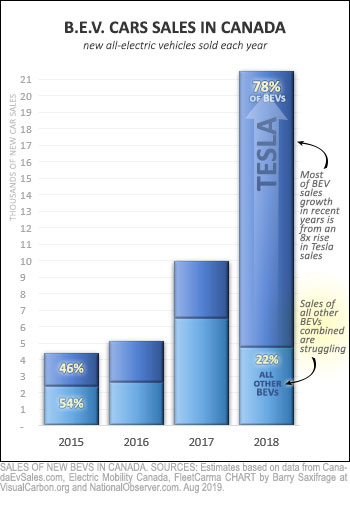
While the overall trend is hopeful, there is a big red climate flag hiding in the details. As my next two charts show, that red flag is the failure of legacy car makers to meaningfully increase the number of BEVs they sell.
Take a look at the top chart that shows the last four years of BEV sales in Canada. As you can clearly see, the sales of BEVs from all the legacy car makers combined have struggled. In fact last year, their combined sales fell.
Nearly all the increase has come from the start-up, Tesla.
The failure of legacy car makers to expand sales of climate-safe vehicles is even more extreme south of the border.
My second chart shows BEV sales in the United States for the first half of each year. InsideEVs publishes detailed monthly sales data for the U.S. that allows me to chart this trend right up to a few weeks ago.
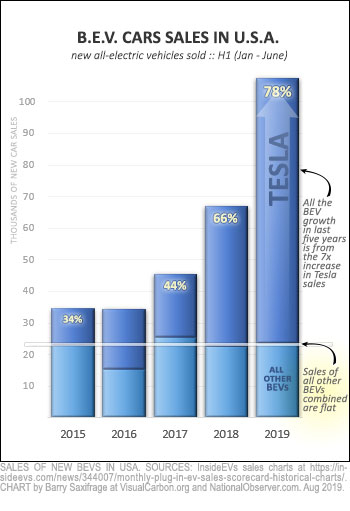
As this chart makes clear, the same troubling trend is playing out there too. Total BEV sales from all the legacy car makers combined has flat-lined for years. This is despite ever growing number of BEV models being offered by these companies.
And again it is Tesla cars that are single-handedly driving the growth in climate-safe vehicles.
While these sales numbers are great for Tesla, it's a serious problem for the fight to preserve a safe climate.
As we saw above, climate safety requires the entire legacy automobile industry quickly transition away from selling gasoline burners. So far they aren't doing that.
Instead, less than one per cent of the vehicles they produce and sell in the U.S. and Canada are the cleanest option, BEVs. The other 99+ per cent have internal combustion engines that burn gasoline.
As the charts above make clear, those tiny BEV percentages haven't changed in any meaningful way for years. This failure of the legacy companies to quickly transition their product line to climate safe options is locking in climate failure.
Transitioning to clean electricity
As we saw above, even BEVs are only clean enough to meet future climate targets if they are charged with clean electricity.
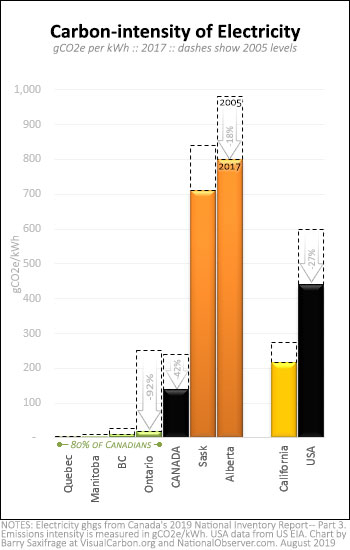
This is one area where Canada already has a big head start.
As my next chart shows, eighty per cent of Canadians live in provinces that already produce super-clean electricity.
In fact, the single biggest climate success in Canada so far has been the elimination of coal-fired electricity in Ontario in recent years. As a result, their electricity emissions have declined by 92 per cent since 2005. Ontario's electricity now emits just 20 gCO2e/kWh.
Electricity in Quebec, Manitoba and BC is even cleaner.
On the far side of the chart you can see that the average across the U.S. is still fairly dirty. But it too has been getting cleaner as they switch away from burning coal. California is currently the biggest BEV market in North America and it too is cleaning up its grid.
Indeed, every region on this chart has been cleaning up their electricity. The dashed boxes show just how much cleaner each region's electricity has become over the dozen years from 2005 to 2017. A dozen years is also roughly the lifespan of the average car. So, if trends continue, BEVs purchased now will continue to get much cleaner as the years go by.
The opposite is expected to happen with gasoline burners, as the oil supplies are projected to become more energy-intensive to extract.
Side by Side
I'll end with an infographic I put together to let you compare the average new Canadian passenger vehicle with an average BEV in Canada's clean electricity provinces. You can see why BEVs like these meet climate goals, and why gasoline burners don't.

————————
The Geeky End Notes
VEHICLE LIFESPAN EMISSIONS — The average Canadian vehicle emits 206 gCO2/km (IEA). And the average car lasts for roughly 200,000 miles (320,000 km) according to data from California Air Resource Board. Those combine to equal 66 tonnes of CO2 for the lifespan of the car.
VEHICLE LIFESPAN GASOLINE USE — A litre of gasoline emits 2356 gCO2 when burned (US EPA). So a car that emits 206 gCO2/km will burn 8.7 L/100km. At that rate it takes 28,000 litres of gasoline to drive the average vehicle's lifespan of 320,000 km. At the current Canadian gasoline prices of $1.25 per litre (gasbuddy.com) it costs $35,000 to buy that much gasoline. Those 28,000 litres weigh 21 tonnes. A barrel of gasoline holds 208 L of gasoline (55 US gallons). So it takes 315 barrels to hold those 28,000 litres.
PLASTIC STRAWS — An average plastic straw weighs 0.42 grams. It takes 400 to weigh the same as the 206 gCO2 emitted per kilometre in the average Canadian car. It takes 10,000 years for nature to remove the fossil fuel CO2 we've added to the oceans that is causing ocean acidification.
CANADIAN ELECTRICITY EMISSIONS — According to Canada's latest National Inventory Report, the carbon intensity of electricity is 20 gCO2/kWh in Ontario; 2 gCO2/kWh in Quebec; 10 gCO2/kWh in B.C.; 2 gCO2/kWh in Manitoba and 14 gCO2/kWh in P.E.I. Eighty percent of Canadians live in these provinces.
LEGACY CAR MAKER SALES — In the U.S. light-duty vehicle sales in the last four years have held steady at just over 17 million vehicles per year. BEV sales from legacy car makers (which excludes Tesla) in the U.S. were 45,000 in 2015 and 47,000 in 2018. These represent 0.3% of sales in each year. The other 97.7% of their vehicles have internal combustion engines.






Comments
Barry,
That was an excellent article. Congratulations!
There is so much new and interesting information in it.
Best, Eduardo
Interesting article. A (friendly) criticism though: you haven't accounted for emissions generated in producing the cars. Electrics would still come out far ahead of conventional vehicles, though.
Oops on second reading I see that you have made clear where you are showing fuel use only vs full life-cycle emissions. I'd be interested to see how that last graphic would look with the full life-cycle emissions, though.
Great article. But it could use a paragraph or two about how the number of cars and the distances driven fit in. The statement "the climate task ahead is two pronged. First, we need to stop buying new vehicles that burn gasoline. . . Second, we need to clean up the electricity supply" leaves out the a crucial third 'prong'.
We can't deal with the climate emergency without tackling automobile dependency. As well as rapidly switching to renewable electric power, we also need to rapidly reduce the number of cars and distances driven. But not a big problem, there are lots of National Observer articles about that third prong: https://www.nationalobserver.com/u/eric-doherty
Thanks for noting this, Eric. You have so many articles on this and it's a great place to start for people wanting to learn more about emissions and pubic transit, car culture etc.
How about some reporting on why vehicle sales of electric cars are so low, except for Tesla? Here's a hint. Manufacturers and dealers don't actively want to sell them (except for Tesla). We tried to test drive a Leaf a couple if weeks ago. We made an appointment, because there are none in the show rooms/lots to drive or even see, and when we showed up for our appointment, there was no car there and we were told by the manager we would need to buy before trying and wait 6-8 weeks. Only the most committed would spend $45k on a car using new technology without a test drive! Btw- we experienced the same when we bought our first Prius. The salesperson's response when we asked to test drive one was to ask 'why do you want to buy one of those'. A different salesperson broke the rules so we could drive one on the lot that had already been sold. Once I see some cars on the lot and advertising in the mainstream media will I believe these car companies/dealers actually want to sell them. We need regulation on volumes of cars that need to be sold or higher gas prices to really see an uptake by the average car buyer.
We have purchased a Leaf and have been operating/driving it for six months now. I think in a way that it is good news that there are waiting lists for Leaf buyers. When a market exists there will always be someone or something to fill the need. We find ourselves in the earliest stages of the evolution of the EV in common use. Hang on they are coming!
Thankyou for the article but a crucial questions needs to be addressed as mentioned in a previous comment. Why are the legacy auto manufacturers not making, marketing and selling BEVs? I can’t watch evening TV anymore because more than half the ads are for big gas hustling pick up trucks and SUVs. Its depressing. I have only once in recent memory seen an ad for an BEV and that was from Toyota. Why are they pushing trucks and SUVs? Is it perhaps because they make bigger margins? Or perhaps the big oil and gas companies have vested interests.
I too tried to purchase a SEV about 5 years ago but it was almost impossible and the sales people were unhelpful and best.
Your investigation has only just begun. Keep going.
One reason for the delay the "Legacy" manufacturers are creating is the simple fact (I think) that the most senior management got to where they are today selling a product that "got them there" and thus have demonstrated a reluctance to invest in such drastic change. I think that it is becoming more obvious on almost a daily basis that the EV is where it's at, including trucks. This will force the change upon GM and Ford and others so that we will witness this decade, a large number of new products (EV's) made available and at competitive pricing.
One reason for the delay the "Legacy" manufacturers are creating is the simple fact (I think) that the most senior management got to where they are today selling a product that "got them there" and thus have demonstrated a reluctance to invest in such drastic change. I think that it is becoming more obvious on almost a daily basis that the EV is where it's at, including trucks. This will force the change upon GM and Ford and others so that we will witness this decade, a large number of new products (EV's) made available and at competitive pricing.
Barry I was going to cite the fuel consumption numbers myself but realised that the GFEI figures all appear to be focused on the efficiency of new vehicles. But of course there are plenty of old vehicles in Canada's fleet. Working Paper 22 says light duty co2 emissions were 198g co2 per 100km... but for new vehicles sold in 2019. The actual overall emissions must be considerably higher! I found the same methodological problem in Natural Resources Canada. (2009). Canadian vehicle survey: summary report. https://publications.gc.ca/collections/collection_2012/rncan-nrcan/M141…